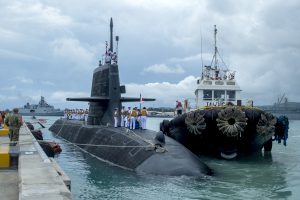Japan launched the first of a new submarine class this week in Kobe.
The 3,000-ton Taigei and its sister ships are larger, quieter successors to Japan’s advanced Soryu-class submarines. Taigei, which means “big whale,” will now undergo testing and outfitting and will likely be ready for operational employment sometime in 2022.
The Taigei brings Japan’s submarine fleet to 22, a goal set by Japan’s Ministry of Defense in 2010 as China’s fleet was growing in size and assertiveness. One more Soryu is under construction to complete the planned class of 12 hulls and a total of seven Taigeis are planned for now, permitting the retirement of some older Oyashio-class submarines nearing the end of their service lives.
China operates six nuclear-powered attack submarines and about 50 conventionally powered attack submarines, though many are older designs.
For quiet operation, the Taigei will use an advanced lithium battery system, pioneered on the last two Soryu submarines built, that will provide it with longer endurance. The batteries are recharged using diesel generators. Japan does not operate nuclear-propelled submarines.
The Taigei class was previously known with the 29SS designation. Earlier speculation about the 29SS predicted a design with a radically more streamlined hull and shrunken sail, making it quieter and more hydrodynamic. The Taigei appears much more conventional than those earlier renderings and more like an enlarged, moderately more streamlined version of the Soryu class.
Japan’s submarines have shorter service lives than most other advanced navies — closer to 20 years rather than 30 or more — so that it can introduce new, more advanced, designs faster. The Soryu class began commissioning 11 years after the older Oyashio class and the Taigei has appeared about 10 years after the first Soryu, so it is reasonable to expect that Japan will introduce an even more advanced submarine sometime around 2030.
Japan is also expected to introduce a new multi-mission frigate soon to patrol its near seas, such as the Senkaku Islands which China claims as its own and regularly sends naval and maritime militia patrols to. Most recently, Chinese coast guard vessels have loitered in the vicinity of the Senkakus for more than a month and made an incursion into Japan’s territorial waters lasting several days, similar to several other challenges to Japan’s administration by Chinese ships this year.
The new frigates will have a crew of about half that of Japan’s larger destroyers. Japan’s shrinking, aging population is stressing the Self-Defense Force’s ability to recruit, and it has been plagued by personnel shortfalls despite implementing measures like raising the maximum age to enter service.

































